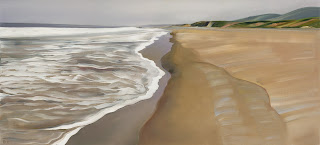Largely unconsciously, my work has been moving towards greater abstraction. Oddly enough this hadn't occurred to me until a show in May, when it was pointed out with criticism on the gallery comment page, and frequently, with mixed reviews, since then. I think this is because I've started down this path frequently for years, pushing abstraction in paintings here and there, so to me the change was so gradual that I didn't notice. Secondly, it just feels natural to become more confident and decisive in simplifying forms and emboldening brushstrokes to be themselves rather than trying to look like a fastideous representation of the subject.
Some of my favorite artists began as representational painters and gradually became pure staunch abstract painters - Rothko and Mondrian, to name a few. It seems for many artists, the evolution of their work moves towards distillation - clarifying for themselves what is and is not important in the way they see the world around them. One of my favorite quotes along these lines comes from Georgia O'Keefe:
“Nothing is less real than realism. Details are confusing. It is only by selection, by elimination, by emphasis, that we get at the real meaning of things.”
And here's another musing I recently found from Arshile Gorky:“Abstraction allows man to see with his mind what he cannot see physically with his eyes....Abstract art enables the artist to perceive beyond the tangible, to extract the infinite out of the finite. It is the emancipation of the mind. It is an exploration into unknown areas.” ―
Both quotes really strike home for me in my work. Over the years, my foregrounds have become bolder and less worked, leaving the details for the viewer to fill with imagination and experience rather than being spelled out. This helps the viewer feel physically present in the painting, as if they are standing or sitting in the foreground themselves. I leave the details for the more distant horizon - perhaps as a way of expressing how we can often see things more clearly with more distance. By making details of the image less specific, the image can be experienced more personally, as each person fills in the details from their own experience.
Below I have included pairs of paintings - the first in each pair from about 10-15 years ago, the second within the last couple years. Though I sometimes miss the ability to focus in on small, beautiful details of the natural world, the direction I've gone in feels natural and right for my own process of "selection, elimination, and emphasis." I see the creative evolution as parallel to one's own personal evolution - there is something valuable about every phase of life, and because it is impossible to go back and recapture or hang on to who we were in our childhood, or 20's, or 30's, it is important to recognize and embrace each season of our lives, especially the current one.




















